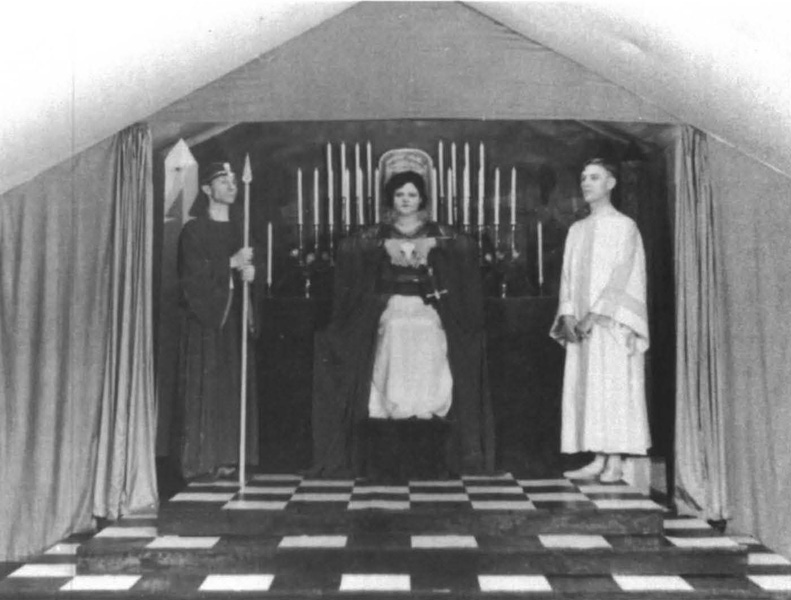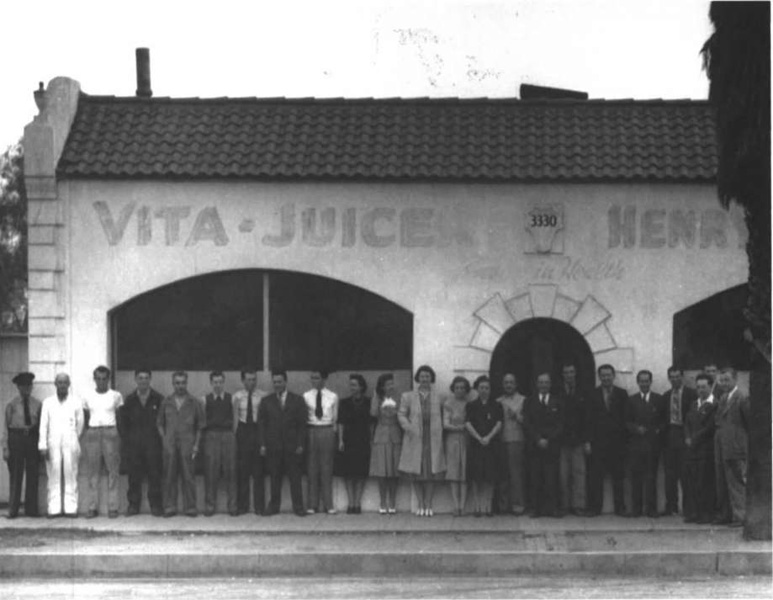Strange Angel (25 page)
Authors: George Pendle

Â

Warburg Institute

Courtesy NASA/JPL-Caltech
(Bottom-left) Parsons, Forman, and Malina pose proudly in front of the Ercoupe.
Courtesy NASA/JPL-Caltech

Aerojet: The Creative Company/Carson Hawk
Â

Warburg Institute

Warburg Institute
(Middle)Frank Malina stands beside the Suicide Squad's dreamâthe WAC Corporalâin November 1945.
California Institute of Technology
(Bottom) Parsons in the late 1940s, shortly before his death.
Warburg Institute
What did you go out into the wilderness to look at?
A reed shaken by the wind?
Â
âM
ATTHEW
11:7
Â
The desert has always been a testing ground. It is a place where devils tempt morals, heat sears endurance, and sheer soundless magnitude confounds the sanity of the solitary man. But it is also fit for transcendence and communion: “There are places where humours and fluids become rarefied,” says Jean Baudrillard, “where the air is so pure that the influence of the stars descends direct from the constellations.” For Aleister Crowley the “beloved Sahara” embodied just such a spirit: elemental, ancient, silent, it was a stage facing out onto the universe on which he could act out his rituals and incantations.
But in 1941 the Californian desert seemed very different to the ancient deserts of Islam in which Crowley had dwelt. While paintings and carvings of antique civilizations peppered the caves and hollows of the Mojave, the rest of the desert was moving to a more fractious, modern beat. Airfields and explosives factories, cement mills and borax blowers, bombing ranges and oil fields now inhabited the landscape. The desert had been turned into science's giant laboratory, an almighty backyard in which scorched earth and noise exploded out against the fossil silence.
Twenty years before, Robert Goddard had been chased into exile in the desertâas all good prophets are. For Parsons, however, the desert had always represented a vast playground. The wide open spaces where he could fire rockets into the eye-blue sky had long offered him a welcome respite from the slide rule and graph paper. Indeed, the Suicide Squad often traveled en masse into the desert to unwind. Hunting trips were the standard entertainment. Armed with rifles and shotguns, the men would take shots at any cottontails and jackrabbits that strayed across their pathâand sometimes at each other. It was on trips such as these that Parsons and Forman were famed for enacting duels. “Jack and Ed Forman decided to play a game,” remembered Caltech graduate student, Homer J. Stewart. “[They stood] fifty yards away from each other, and they shot at each other. Now the rule was that who came closest without hitting won.”
The duels attested to the pair's bare-chested machismo and the continuing closeness of their relationship. “They were both daredevils,” remembered Jeanne Ottinger, Forman's stepdaughter; “whatever Jack suggested, Ed was going to go right along with.” But the duels were also declarations of intent; both men reveled in testing the boundaries of the sane and the safe, just as they did in their work on rockets. “They both wanted to try anything, do anything,” remembered Ottinger. “They thought that nothing was impossible.” Neither man was ever hurt in the duels; indeed, the game usually ended when dirt flew up inches from one of the men's feet. For the other members of the Suicide Squad (how ominous the name must have sounded during these moments), the game was entirely characteristic of the twoâsomewhat discomfiting, somewhat rash. But they took it, as they did so many eccentricities within their ranks, with a shake of the head and an exhalation of breath. “That was Jack, that was Edâthey were crazy, what could you do?”
The desert would now be the backdrop for a project whose future hung uncertainly between the possible and improbable. In the spring of 1941, the Suicide Squad informed the army air corps that the group's JATO rockets would be ready for testing in early August. Parsons had been changing and improving the JATO's fuel. Nevertheless, it still seemed to be made up of the contents of a schoolboy's desk. He pressed amide black powder mixed with corn starch and ammonium nitrate into the blotting paper-lined rocket, the whole mixture being bound together with Le Page's all-purpose stationery glue. Fred Miller, an engineer from Caltech who had recently joined the expanding project, called it “the goop,” but officially it bore the more specialized name of “GALCIT 27,” since it was the twenty-seventh unique fuel Parsons had created in the last few months.
The rocket motor which held this powder seemed equally primitiveâone foot long, three inches in diameter, and made of one-inch-thick steel, it held three pounds of propellant compressed under 1,800 pounds of pressure. The three pounds of fuel would burn for a wonderfully lengthy twelve seconds while delivering a small but punchy twenty-eight pounds of thrust. The propellent was by no means as powerful as some of the liquid rocket fuels they had been experimenting with, but it was enough to aid a small plane in getting off the ground and thus provide that most important commodity for the rocketeersâa spectacle.
The group decided to adapt a small 753-pound single-engine Ercoupe, a civilian monoplane, for the tests. The plane was easy to handleâanyone who could drive a car could fly itâit didn't go into spins, and it was very cheap in case anything went wrong. One of Kármán's graduate students, the thirty-two-year-old Homer Boushey, a tall, bluff San Franciscan who was also a lieutenant in the army air corps, agreed to be the pilot. Boushey had also bought in to the romance of rocketry. From his earliest days in flight school, he had been fascinated by Goddard's work. Displaying the precociousness of almost all rocket amateurs of the time, he had even corresponded with Goddard about the possibility of developing rocket propellers. Such an offbeat hobby had not been looked on kindly by his army superiors, however, and they had ordered him to forget rocketry and instead to concentrate on “flying the mail” in his open-cockpit biplane. Their skepticism, however, failed to quench his interest, and now when offered the chance to take a leading role in a serious rocketry experiment, Boushey found it hard to resist.
He almost immediately began to wonder if he would regret this decision. A week before the flight tests were to begin, Boushey visited the rocketeers to see how the JATO rockets were coming along. What he saw could not have been encouraging. The rocketeers were casually strolling to and fro in various states of undress. Martin Summerfield had even set up home in one of the fifteen-foot-by-fifteen-foot tin shacks that the Suicide Squad had built; his underpants and socks hung unceremoniously from the gauges and motors.
Parsons himself was bedraggled and worn out. He had, since April, been holding the talks he had promised the OTO. These took the form of twice weekly discussion groups held at his home that touched on literature and mysticism. Members of the OTO were present, as well as a few students from Caltech who had become intrigued by Parsons; his interests seemed a world away from the campus pastimes of glee clubs and golf. The evenings dragged on late as records were played and poetry was read and discussed. At the same time, the OTO house at Winona Boulevard had undertaken a new publicity drive, holding parties to raise money and spread awareness of the cause. Parsons was at the center of these, joking and declaiming, his eyes wandering over the young bohemians who had been curious enough to attend. Spiked punch would be served before Parsons diligently and persuasively suggested that if his guests wanted an “experience,” they really ought to watch the Gnostic Mass in the house's attic. In the mornings after his late-night activities, an unkempt Parsons could be seen shuffling across the Arroyo, flinching in perceptible agony as his rockets belched and screamed.
On the day that Boushey visited, the rocketeers were running a technical rehearsal. Parsons had set up six JATOs on a metal rack, simulating the rack that would be attached under each of the test plane's wings. The group of rocketeers, including Kármán, waited anxiously fifty yards away, behind a wall of sandbags. Parsons, cigarette in hand and feeling poorly, rushed through the countdown in his usual style. He pushed the firing button. “Explosions occurred like on the Fourth of July,” remembered Kármán; “nozzles flew off in all directions. It couldn't have been any worse.” Parsons was left horribly sobered.
